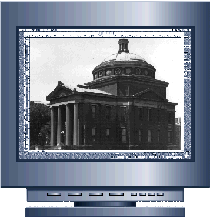

N E W S T R U C T U R E S F O R N E W I D E A S
A palimpsest of fiefdoms:
interdisciplinary centers
Columbia has a long history of shaping new fields through new forms of academic organization--anticipating the campusless modern university, where ideas outpace physical and departmental structures
By KEN HOWARD
 IN 1927,
FRANZ Boas, Columbia's renowned professor of anthropology, wrote a letter to President
Nicholas Murray Butler asking for money and a building to enhance the cooperation of
"anatomists, anthropologists, physiologists, pathologists, psychologists and
sociologists."(1) That same type of request would
hardly be out of place today, but there's a good chance it would be made over e-mail. A
separate building would be redundant because of existing computer networks. The
collaboration could end up saving the university money, as a number of departments shared
the cost of starting and running a new initiative. Creative organizational forms and digital
technology have modernized the notion of interdisciplinary studies.
IN 1927,
FRANZ Boas, Columbia's renowned professor of anthropology, wrote a letter to President
Nicholas Murray Butler asking for money and a building to enhance the cooperation of
"anatomists, anthropologists, physiologists, pathologists, psychologists and
sociologists."(1) That same type of request would
hardly be out of place today, but there's a good chance it would be made over e-mail. A
separate building would be redundant because of existing computer networks. The
collaboration could end up saving the university money, as a number of departments shared
the cost of starting and running a new initiative. Creative organizational forms and digital
technology have modernized the notion of interdisciplinary studies.Communication between fields has always been a hallmark of great research universities. As the institutions grow, with corresponding increases in both physical and disciplinary distances, collaborations tend to move from the informal (a stroll across campus to converse with a colleague) to the more structured (such as the Manhattan Project, which brought together members of several academic departments at Columbia to facilitate the creation of the first atomic bomb). There are no goals currently being sought as urgently as Columbia scientists once pursued the bomb, but faculty continue to forge relationships in the spaces between disciplines. Unlike projects of the past, today's interdisciplinary entities are becoming less transitory, more a part of the university's structure--and as a uniquely situated institution, unable to expand its geographic space within upper Manhattan, Columbia has developed hybrid centers and institutes as its preferred strategy to enlarge and strengthen itself.
At last count, Columbia had 65 centers, 22 institutes, and myriad programs, projects, and informal collaborations that have never been officially counted. These collaborations span all schools within the university. The Health Sciences campus is the epicenter of interdisciplinary activity, possibly because of the medical establishment's early responsiveness to marketplace demands: Money follows the populace's call for cures for disease, and this effort has often required mergers of individual disciplines such as biology and chemistry. Collaborations grew, staffs developed, funding appeared, and centers emerged. "Increasingly, the complexity of the problems in medicine requires contributions from many different departments," says Robert E. Canfield, Irving Professor of Medicine at the College of Physicians and Surgeons.
The rest of the university has followed suit, increasing not only the number of centers but their size and scope. Collaborations like the Amiens Project and the Gateway Laboratory combine the efforts of a number of disciplines in pursuit of goals requiring intellectual or technological synergies, such as the application of computer power to expand undergraduate instruction in the arts or to create new opportunities in engineering and design. A center or institute seems by definition to have a broad mission, to create a structure that extends beyond the basic perimeters of a single discipline. As Lewis Freeman, director of Columbia's Speech Program, explains, while noting that Speech is one example of an interdisciplinary program that serves all schools, departments, and offices, a university is unlikely to see a need for "a First Year English Course Institute."
Collaborative efforts between disciplines now emphasize breadth of scale. "It is the university's desire to step out on a global basis rather than tackle small, reductionistic science problems," says Vice Provost Michael M. Crow. Perhaps the most ambitious of these collaborations is the Global Systems Initiative, a new enterprise that seeks to bring together natural and social science studies to analyze and influence the changes taking place on Earth. Technology has both precipitated and made more obvious the physical, social, and political interconnectedness of worldwide problems; it is the aim of the Columbia initiative to step into a situation where, as Crow puts it, "human beings have become the managers of the planet." The GSI acts as an umbrella for established interdisciplinary groups, such as the Center for Environmental Research and Conservation, Biosphere 2, facets of the Graduate School of Business, the School of Public Health, Lamont-Doherty Earth Observatory, and Barnard College, as well as linkages to outside institutions, such as the American Museum of Natural History and the New York Botanical Garden.
 Mobilizing
such a large undertaking means shaking departmental lines, political barriers, and grips on
valued resources. This is often guided by bottom-line considerations. "We seek to create
the best structure with the lowest operating costs," says David Cohen, vice president for
arts and sciences. Interdisciplinary centers allow efficient use of funds, in addition to
attracting funding in the first place. Economies of scale, however, are by no means the sole
justification for new centers. "The money is not drying up," avers Crow;
"it's just changing course. Calculation of social profit has become as important as
scientific profit."
Mobilizing
such a large undertaking means shaking departmental lines, political barriers, and grips on
valued resources. This is often guided by bottom-line considerations. "We seek to create
the best structure with the lowest operating costs," says David Cohen, vice president for
arts and sciences. Interdisciplinary centers allow efficient use of funds, in addition to
attracting funding in the first place. Economies of scale, however, are by no means the sole
justification for new centers. "The money is not drying up," avers Crow;
"it's just changing course. Calculation of social profit has become as important as
scientific profit."
The institutional life cycle
 UNLIKE
CREATING NEW departments from offshoots of established disciplines, as in the formation
of urban studies, women's studies, and Southeast Asian studies--an effort that often requires
structural changes, staff additions, significant funding, and ingrained opposition from
departments weary of competing for more limited resources--centers may be a way of
spreading a department's influence into new areas without incurring high costs or taking away
from existing programs. These collaborations act in some respects as public relations firms for
a discipline, showing other members of the university and the public how a department's work
is relevant outside its perceived terrain. Crow describes it as "a way of adding a
dimension without destroying a core discipline."
UNLIKE
CREATING NEW departments from offshoots of established disciplines, as in the formation
of urban studies, women's studies, and Southeast Asian studies--an effort that often requires
structural changes, staff additions, significant funding, and ingrained opposition from
departments weary of competing for more limited resources--centers may be a way of
spreading a department's influence into new areas without incurring high costs or taking away
from existing programs. These collaborations act in some respects as public relations firms for
a discipline, showing other members of the university and the public how a department's work
is relevant outside its perceived terrain. Crow describes it as "a way of adding a
dimension without destroying a core discipline."
Inevitably, however, growth in an environment of finite resources also produces casualties. "The university has a terrific ability to gestate newly conceived entities and ideas but has no concept of death," says Provost Jonathan R. Cole. While seed money for starting new collaborations is usually not a strain on existing budgets, the demise of some programs can be the inevitable stepchild of innovation--and institutions, like people, often prefer to cast a blind eye to their own death rather than confront it directly. "The energy required to eliminate departments, centers, or institutes is enormous," says Cole. "There's a real threat to mediocrity creeping in because of the spread of too few resources over a growing base."
These bodies die slowly, usually over a period of five to 20 years, estimates Crow. The elimination of departments or programs happens over time through neglect, or an evolutionary process of differentiation and consolidation, rather than by single acts of destruction. By most estimates, interdisciplinary programs are gaining momentum and influence, possibly superseding some traditional departments. Says Arthur Levine, president of Teachers College: "There's more money now for interdisciplinary activity; it's becoming more common, reaching a critical mass. There's a change in thinking, that boundaries need to be crossed to solve problems."
Many intellectual problems are addressed as research within the institutes and only later filter down into undergraduate teaching. However, collaborations that have a direct impact on undergraduate education often act as a bridge between research and teaching. Gateway Laboratory, for example, uses software originally designed for molecular research as a teaching tool; a new electronic library, part of a new curriculum for geology and environmental science majors, is being created with data from Lamont-Doherty Earth Observatory and with input from the School of International and Public Affairs, the business school, the chemistry department, and the medical school. "We want to teach students that they can teach themselves, and we want to expose them to the richness of asking questions using real data, as opposed to using books where data and results are oversimplified," says Stephanie Pfirman, chair of the environmental sciences department at Barnard. "We want to show students that there are a lot of interesting unanswered questions out there."
Welcome to the cyberversity
WHAT MAKES MANY of these collaborations possible, from the far-flung enterprises of the Global Systems Initiative to the more centralized geology library, is the ability to communicate. This is increasingly a function of access to the Internet and intracampus networks. This ability to drive an interdisciplinary program by facilitating timely exchange of information also has an effect on the relations between divisions at Columbia.
 "One of
the interesting things that may come out of the use of digital technology is the reversal of the
way education activities and research activities have historically diverged from one
another," says Robert McClintock, who heads the Institute for Learning Technologies, a group that
evaluates and develops computer resources for all levels of the university. As in the geology
library, research information can become quickly available to undergraduates, and the
electronic format allows students to manipulate the information to resemble more closely a
real-world setting. Electronic tools also have allowed data from the real world to exist in
virtual reality, so that a huge storehouse of information can be held in bytes rather than bins.
This not only allows quick access and manipulation of data but often obviates capital
expenditures for new buildings. This has created a nurturing environment from which centers
and institutes can grow, helping what Crow calls Columbia's "organizational
footprint" to expand.
"One of
the interesting things that may come out of the use of digital technology is the reversal of the
way education activities and research activities have historically diverged from one
another," says Robert McClintock, who heads the Institute for Learning Technologies, a group that
evaluates and develops computer resources for all levels of the university. As in the geology
library, research information can become quickly available to undergraduates, and the
electronic format allows students to manipulate the information to resemble more closely a
real-world setting. Electronic tools also have allowed data from the real world to exist in
virtual reality, so that a huge storehouse of information can be held in bytes rather than bins.
This not only allows quick access and manipulation of data but often obviates capital
expenditures for new buildings. This has created a nurturing environment from which centers
and institutes can grow, helping what Crow calls Columbia's "organizational
footprint" to expand.
 Departmental fiefdoms have been around since Columbia's inception; they
have proven resilient. Ultimately, people have to be convinced of the benefit of a more
collaborative approach to research. "Developing a culture which is different from the
past, and which will have the strongest possible impact down the road a few years, still has a
long way to go," says Morton B. Friedman, vice dean of the School of Engineering. "We're still
struggling with the pieces." But technology is putting faculty in touch with distant
colleagues, changing the flow of communication and reshaping disciplines; a researcher may
now have as much daily contact, exchange of ideas, and sense of shared loyalty with an e-mail
discussion group as with colleagues who share a hallway. As electronic media allow scholars to
extend their professional contact networks more readily into other institutions, it's only
natural that they look across departmental boundaries within their own institution as
well.
Departmental fiefdoms have been around since Columbia's inception; they
have proven resilient. Ultimately, people have to be convinced of the benefit of a more
collaborative approach to research. "Developing a culture which is different from the
past, and which will have the strongest possible impact down the road a few years, still has a
long way to go," says Morton B. Friedman, vice dean of the School of Engineering. "We're still
struggling with the pieces." But technology is putting faculty in touch with distant
colleagues, changing the flow of communication and reshaping disciplines; a researcher may
now have as much daily contact, exchange of ideas, and sense of shared loyalty with an e-mail
discussion group as with colleagues who share a hallway. As electronic media allow scholars to
extend their professional contact networks more readily into other institutions, it's only
natural that they look across departmental boundaries within their own institution as
well.
"Colleges make one very big mistake," observes Arthur Levine: "They don't realize they're not in the campus biz, they're in the education industry." If the physical campus is becoming obsolescent in the electronic era, and a culture of border-crossing is coming to permeate intellectual life, Columbia's tradition of exploring untraditional forms of organization is likely to serve as an established model for 21st century education.
PHOTOS: Office of Public Information/Joe Pineiro (1,3&4)
KEN HOWARD is a free-lance
writer whose work has appeared in The Sciences and Scientific
American.




